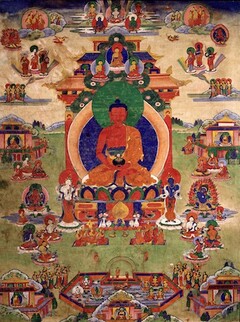The Story of Lady Fe
The Story of Lady Fe[1]
from the Ḍākinīs' Great Dharma Treasury
In a region called Hfen Yang,[2] there was a woman who belonged to the Fe clan. Throughout her entire life, she focused her mind on the buddha Amitābha and recited his name. To count her recitations, she used small lentils. When put all together, they amounted to thirteen dre measures.[3]
When she was on her deathbed, she said to her family, “The buddhas have prepared a throne for me. It’s time for me to go to Sukhāvatī.” She then straightened her body and passed away.
It is said that just that moment, flowers of five colors rained from the sky, and all the local people witnessed auspicious signs.
This was translated from Chinese into Tibetan by Khenmo Dawa Drolma.
| Translated by Joseph McClellan, 2025.
Bibliography
Tibetan Source
mkhan mo zla ba sgrol ma, trans. phe tshang gi mna’ ma. (2017). In mkhaʼ ʼgroʼi chos mdzod chen mo (Par gzhi dang poʼi par thengs dang po, Vol. 8, p. 278. Bod ljongs bod yig dpe rnying dpe skrun khang. BDRC MW3CN2459_98B305
Secondary Source
Sheng-yen. 1985. “Esoteric and Esoteric Buddhism.” Ch'an Newsletter 45. https://www.chancenter.org/chanctr/ddp/channews/05-1985.html
Version: 1.0-20250401
-
phe tshang gi mna’ ma. More literally, “The Bride from the Fe Clan” is found in the Ḍākinīs' Great Dharma Treasury (mkha’ ’gro chos mdzod chen mo) in a section dedicated to the life stories of Chinese women saints that were translated into Tibetan by Khenmo Dawa Dolma (mkhan mo zla ba sgrol ma, 20th c.). The story itself appears to derive from the Chinese oral tradition and likely has many variants. For example, a story with similar elements is found in Sheng-yen 1985. ↩
-
hphen yang ↩
-
A dre (bre) is a traditional volume measurement equaling about two pints. ↩
